Are you a Quiet Speculation member?
If not, now is a perfect time to join up! Our powerful tools, breaking-news analysis, and exclusive Discord channel will make sure you stay up to date and ahead of the curve.
About three weeks ago, I was talking Modern with a Magic-playing friend of mine. He and I were debating flex slots in UG Infect and whether it would be better to take Eldrazi or anti-Eldrazi to Grand Prix Detroit. One of those questions is an interesting conversation for specialists like Tom Ross. The other is equal parts tragedy ("How could this happen...?") and comedy ("lol @ Modern"). Tentacles aside, we were having an enjoyable discussion when his little brother interrupted. The brother, a 7th grader, had been listening and wanted to know more about this Magic utopia where big-mana Timmy decks coexisted with Turn 2 kills. He asked a simple question: "What is Modern?" His older brother tried explaining and got bogged down in "nonrotating format." I tried explaining and got stuck at "successor to Legacy." After stumbling around Google on our smart phones for 15 minutes, we realized the answer to this elementary question was surprisingly elusive. And that, ladies and gentlemen of Modern, is a problem.
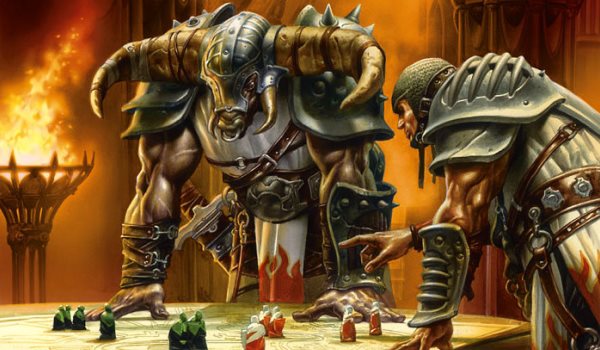
I've promised to do a column on Modern management, policy, and communication issues for a while. Today's article is the first in that "Fixing Modern" series. Each entry will have three objectives. First, identifying a particular Modern problem. Not just a "Where's my freaking Innocent Blood?" problem. Rather, high-level problems with Wizards' managing Magic's second most-popular Constructed format. Second, explaining why it is a problem. Finally, proposing solutions to that problem. I understand some readers won't buy "Fixing Modern's" premise in the first place. "Does Modern really need fixing?" "What makes you an authority on those fixes even if it is broken?" These are appropriate questions and I'll try addressing them in each article. Today, we'll tackle the fundamental question of "What is Modern?" both because it's a critical foundation for all other Modern inquiries, and so none of us get stumped by a 7th grader.
[wp_ad_camp_1]
Current Definitions of Modern
It's not entirely fair to say that no one has an answer to the "What is Modern?" question. There are plenty of responses out there but, as we'll talk about in this first section, many of those Modern definitions are inconsistent and inaccurate: even at the Wizards level. This underscores the need to see what's currently out there and check if any of the existing definitions pass muster. Final note: I'll be mostly using the concept of "mission," "purpose," and related terms interchangeably. I get enough of those overly-nuanced differences in my work at nonprofits, and I don't need to bring that granularity here.
Asking the players
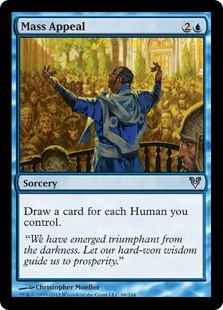 Imagine you're playing Modern at a local Friday Night Magic. Also, imagine it's either after the April bannings or before Pro Tour Oath of the Gatewatch, or you're probably playing alone. You're running the exciting Abzan Company vs. Jund matchup and curious Standard or Limited players approach you, asking what format you're playing. Let's assume they aren't entering with preconceived notions about Modern's banlist (don't worry: "Fixing Modern" will tackle ban mania soon enough) and just want to know "What is Modern?" How do you answer?
Imagine you're playing Modern at a local Friday Night Magic. Also, imagine it's either after the April bannings or before Pro Tour Oath of the Gatewatch, or you're probably playing alone. You're running the exciting Abzan Company vs. Jund matchup and curious Standard or Limited players approach you, asking what format you're playing. Let's assume they aren't entering with preconceived notions about Modern's banlist (don't worry: "Fixing Modern" will tackle ban mania soon enough) and just want to know "What is Modern?" How do you answer?
Here are some response I've given and heard from various players:
- "It's a nonrotating format with (basically) all new-frame cards from 8th Edition until today."
- "It's a super diverse format where you can play almost any deck and archetype."
- "It's where you can go to play all your old Standard cards."
- "It's like Legacy, but closer to Standard power-level."
- "It's like Legacy, but less powerful and without the Reserve List problems."
- "It's like Legacy, but just worse."
These replies are not supposed to be a truly representative sample, but I'm confident they are close to your own experience. As we can also attest, it takes about five minutes of browsing r/ModernMagic, forums like MTG Salvation, or the comment section of most StarCityGames and ChannelFireball articles to see similar disagreements. One example: pro-grinder Peter Shmanka posted "A Message to the MTGS Community and Wizards of the Coast" about Modern issues. Going through that discussion, I spotted at least 15 distinct definitions of Modern in its 22 pages. Obviously, one cursory examination of a forum thread does not a formal analysis make, but it supports an impression many of us have from talking about this issue in person.
Asking Wizards
Then again, perhaps these disagreements are inevitable at the player level. I'm not seeing an outcry to #FixStandard (Siege Rhinos aside) and I doubt many Standard players could give 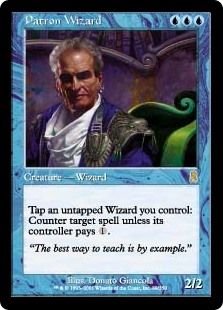 succinct definitions about what their format is about either. Maybe all that's needed is for Wizards themselves to have a clear definition of the format. Or for Wizards to disseminate that definition, even if the player-base is too busy raging on Twitch chat to research it.
succinct definitions about what their format is about either. Maybe all that's needed is for Wizards themselves to have a clear definition of the format. Or for Wizards to disseminate that definition, even if the player-base is too busy raging on Twitch chat to research it.
Thankfully, Wizards offers a few resources, both current and older, to answer the "What is Modern?" question. Let's go through a number of the most succinct definitions I found on the Wizards website, starting with the most descriptive statements: those purely defining Modern's scope:
"Cards from Core Set Eighth Edition and Mirrodin through today are legal in this format. Again, decks require a minimum of sixty cards and may have a sideboard of up to fifteen cards."
Wizards website, "Formats" (current)
"Introduced in 2011, Modern is a format designed to bridge the gap between Standard (which rotates sets once a year) and Legacy (a non-rotating format that allows cards from all of Magic's history). Expansions and core sets with the newer card frame (starting with Mirrodin and Eighth Edition) are legal in Modern."
magicthegathering.com staff, "Modern" (December 19, 2012)
At this level of definition, there isn't much disagreement. Love or loathe Modern, it's impossible to deny the format parameters, even if we could argue ad nauseam about the arbitrary decision to start at Mirrodin and not earlier/later. Here, at least, there is consensus at both the Wizards and player level.
Our next tier of definition transcends the descriptive to something approximating a Modern "purpose." That is, not just defining what cards Modern contains, but also what the format is supposed to accomplish for players and the game of Magic as a whole.
"...many of you have called for a non-rotating format that doesn't have the card availability problems of Legacy. We propose Modern as that format."
Tom LaPille, "A Modern Proposal" (May 26, 2011)
"Modern contains all cards released in core sets from Eighth Edition forward and expansion sets from Mirrodin forward. The format doesn't rotate, and new sets become legal in Modern on release... In many ways Modern is like a Greatest Hits of Magic format, that allows people to play pretty much any of their [favorite] decks from the past eight years."
David Sutcliffe, "Feature: A Modern Primer" (September 1, 2011)
Now we're getting somewhere. LaPille and Sutcliffe introduce two concepts that have remained central to Modern despite being written about in 2011. The first is the notion of addressing Legacy's "card availability problems." As Wizards has repeated more times than Marco Rubio has parroted his memorized 25 second speech, the Reserve List isn't going anywhere, which isn't great if you want Legacy to have Modern-level support while also keeping Candelabra of Tawnos under $500.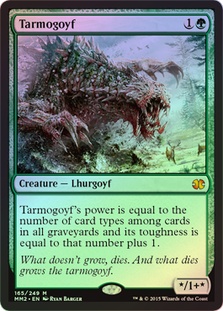 From its formation, Modern has been a solution to this availability issue, and even if prices don't always feel like they align with that mission, they are significantly lower than they would be if Legacy was the Pro Tour format.
From its formation, Modern has been a solution to this availability issue, and even if prices don't always feel like they align with that mission, they are significantly lower than they would be if Legacy was the Pro Tour format.
Moving away from the sticky domain of prices and availability, Sutcliffe talks about Modern's purpose with respect to its cardpool. As Standard rotates, players need to migrate somewhere with their old staples and decks. Moreover, players from past Standard environments wanted to bring all their Arcbound Ravagers, Cryptic Commands, and Wild Nacatls out of retirement. Modern is the promised land for both groups, giving one a place for old Standard and Extended strategies, and offering an ever-evolving home for staples as they rotate out of Standard.
LaPIlle's and Sutcliffe's definitions bring us to a gem from the unfailingly informative Sam Stoddard (seriously: read every article that man writes). Stoddard's definition synthesizes both the descriptive and more goal-oriented Modern statements into one pithy, em-dashed sentence.
"Modern has provided us a non-rotating format that is far more accessible than Legacy or Vintage, but still retains many of the qualities that people enjoy in those formats—such as a more stable metagame, the ability to play and tweak the same deck week after week, and simply a much more powerful card pool than Standard."
Sam Stoddard, "Developing Modern" (June 21, 2013)
Amen, Sam Stoddard! In this one excerpt, Stoddard captures it all. He highlights accessibility issues and Modern's spiritual overlap with Eternal offerings. He talks about power-level relative to Standard. He even discusses the inherent appeal of a nonrotating format in their metagame stability and deck consistency. Although we could wordsmith a bit (what does "accessible" mean?) and clarify certain statements (how "much more powerful" should Modern be than Standard?), this is overall a strong definition and one I'd be comfortable repeating.
Asking for trouble
Here's the problem: Stoddard's quote never gets repeated. I mean this both literally, in that no one ever repeats his words in a future Wizards article, and conceptually, in that some of the most important Modern content doesn't even allude to it. For one, we've already seen the absence of a defining mission on the "Formats" page. That reads as a startling omission: in the internet era, this will be one of the first places for prospective Moderners to acquires information. Why not give them a clear definition? More worryingly, we see these definitional inconsistencies and obscurities in some of the most public prologues to Modern. Take the preview articles for Pro Tour Fate Reforged and Oath from 2015 and 2016:
"What makes Modern so wonderful is that there are so many decks that you can play, covering every conceivable play style, and with every opportunity to outfox, outwit, outspeed, outfight, outdraw, outthink, or plain old outpunch your opponents... Modern lies in the sweetest of spots where everything you do can feel simultaneously extraordinarily powerful, and yet also vulnerable. Gratuitous, yet not inherently unfair. Modern is a format where almost anything goes"
Rich Hagon, "Pro Tour Fate Reforged Preview" (February 2, 2015)
"Modern is a format where crazy is run-of-the-mill, where devastating isn't just for Zac Hill, and where the power level in each and every deck is truly stacked."
Rich Hagon, "Pro Tour Oath of the Gatewatch Preview" (February 1, 2016)
Those aren't definitions. At best, those are advertisements, and I live in a Super Tuesday state 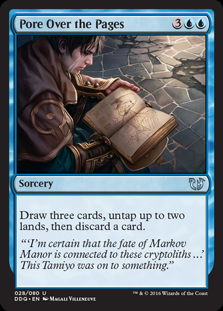 so I know a thing or two about advertisements. At worst, they are buzz and fluff. I'm leaning towards the former due to the promotional aspect of the Pro Tour, but given some other issues with Pro Tour coverage and its tendency to oversell, the latter is equally possible. However you interpret them, Hagon's pitches do not echo Stoddard's clear, nuanced, and comprehensive definition given 2-3 years earlier. This, despite Hagon's quotes coming from the introductory articles to quite possibly the largest spectator events of the Magic year. If anything, the quotes highlights some of Modern's most glaring weaknesses more than its strengths: lack of interaction, excessive speed, and over-the-top power level. Compare Hagon's Modern descriptions with Mike Rosenberg's Legacy snippet from 2015's Grand Prix Seattle-Tacoma:
so I know a thing or two about advertisements. At worst, they are buzz and fluff. I'm leaning towards the former due to the promotional aspect of the Pro Tour, but given some other issues with Pro Tour coverage and its tendency to oversell, the latter is equally possible. However you interpret them, Hagon's pitches do not echo Stoddard's clear, nuanced, and comprehensive definition given 2-3 years earlier. This, despite Hagon's quotes coming from the introductory articles to quite possibly the largest spectator events of the Magic year. If anything, the quotes highlights some of Modern's most glaring weaknesses more than its strengths: lack of interaction, excessive speed, and over-the-top power level. Compare Hagon's Modern descriptions with Mike Rosenberg's Legacy snippet from 2015's Grand Prix Seattle-Tacoma:
"Comprised of some of Magic's most powerful cards from 1993 until today, Legacy Constructed is a format where there are a multitude of deck options that all fall within some distinct categories—go aggressive, control the pace of play and win late, or assemble a combo and win quickly—that all tackle their category's game plan through different ways. The result is a format showcasing the greatest hits of Magic's 22 year history where players are likely to find a deck, fall in love with it, and stick with it for as long as they want."
Mike Rosenberg, "The Vastness and Draw of Legacy" (November 7, 2015)
This is a much more evenhanded, accurate, and overall appealing first impression of a non-Standard format. That is troubling. Seattle-Tacoma was only a Grand Prix, not the high-viewership Pro Tours in February 2015 and 2016. Wizards has been promoting Modern at the Pro Tour, Worlds, Pro Tour Qualifier, Regional Pro Tour Qualifier, FNM, and local level. Legacy just gets three Grand Prix tournaments per year. Given this lopsided support, I would think Wizards would have a concise and glowing mission statement for Modern. Instead, we get Rich Hagon waxing poetic. Is it possible that Hagon and the coverage team were trying to be more amusing than descriptive? Sure! But when compared to Rosenberg's quote, and the overall inconsistencies in presenting Modern's purpose, those introductions to the Pro Tour read as more confused than comical.
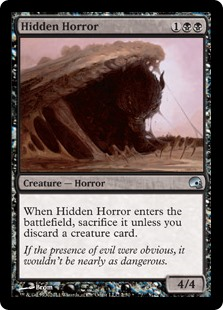 As we can see, there is a series of major problems hidden (and not-so-hidden) beneath these seemingly concise quotes. Even Stoddard's! Why is the best definition of Modern from a random column in 2013? Why aren't similar Modern descriptions given in the Pro Tour primers for either 2015 or 2016? Why do Modern aficionados have to spend over an hour scouring Google and the Wizards archives to find these quotes? Is Wizards even following the best of these definitions? These problems, and many more, are central to our next section as we start unpacking why these citations fall short of defining Modern and why that is a serious issue for our format.
As we can see, there is a series of major problems hidden (and not-so-hidden) beneath these seemingly concise quotes. Even Stoddard's! Why is the best definition of Modern from a random column in 2013? Why aren't similar Modern descriptions given in the Pro Tour primers for either 2015 or 2016? Why do Modern aficionados have to spend over an hour scouring Google and the Wizards archives to find these quotes? Is Wizards even following the best of these definitions? These problems, and many more, are central to our next section as we start unpacking why these citations fall short of defining Modern and why that is a serious issue for our format.
Problems with Existing Definitions
Modern generates a lot of argument. I'm not just talking arguments over Chinese vs. pizza for Tuesday takeout (last night: Pizza 1, Chinese 0). I'm talking Second Amendment heated, but reduced to the Magic scale (even if the strong language doesn't make it feel very reduced). These arguments include the banlist, the Pro Tour, format health, deck and archetype viability, the banlist, the turn four rule, reprints, prices, testing, and, you guessed it, more of the banlist.
I believe many of those issues are eventually worth addressing in "Fixing Modern." But I also 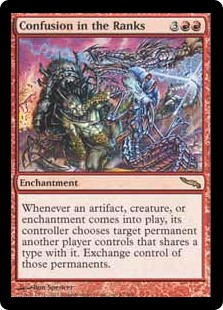 believe every single one of them returns to the community's, and apparently Wizards', uncertainty in answering "What is Modern?" If we could respond decisively to this core question, we could use that Modern mission as an arbiter for other format-related disputes. Unfortunately, as we saw in the previous section, neither Wizards nor players can do this. Players disagree at almost every level: just try my "What is Modern?" question the next time you're at the local game store. Wizards either doesn't have a unified definition it publicly acknowledges to players, or doesn't even have an internal one in the first place. This makes it impossible to link seminal debates (e.g. the banlist) to a Modern-wide mission: there's no mission to actually link back to.
believe every single one of them returns to the community's, and apparently Wizards', uncertainty in answering "What is Modern?" If we could respond decisively to this core question, we could use that Modern mission as an arbiter for other format-related disputes. Unfortunately, as we saw in the previous section, neither Wizards nor players can do this. Players disagree at almost every level: just try my "What is Modern?" question the next time you're at the local game store. Wizards either doesn't have a unified definition it publicly acknowledges to players, or doesn't even have an internal one in the first place. This makes it impossible to link seminal debates (e.g. the banlist) to a Modern-wide mission: there's no mission to actually link back to.
Take the controversial "turn four rule" as an example. Pretend you are explaining the rule to someone who has never heard of it before and you try connecting it to some semblance of a Modern mission. For reference, here's the most recent turn four rule text as cited from the Summer Bloom banning decision:
"When a format becomes imbalanced, or too many games are not interactive, we examine the cause... We look for competitively viable decks that frequently win before the fourth turn."
Wizards of the Coast, "January 18, 2016 Banned and Restricted Announcement" (January 18, 2016)
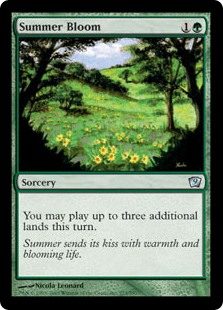 Try using the quotes in our first section to justify this rule. If you turn to the basic set legality descriptions on the "Formats" page, you can't. There's nothing in that outlining of set cutoffs that justifies banning Summer Bloom. Even the Modern format page itself is mute to this, just explaining the existence of a banlist and not its rationale. What about Stoddard's definition? Now there's a much better example, because we can see how a consistent turn four 2-3 winner might not lead to the goal of a "stable metagame" if that metagame can't regulate the deck. In that case, Stoddard's quote would help us explain the rule and justify it to a Modern layman. And Hagon's? Not only do the Pro Tour Preview quotes fail to explain the turn four rule, they actually create confusion around it. They leave us asking about why some "extraordinarily powerful but vulnerable" strategies are okay and others are not. Here, the absence of a distinct Modern purpose hamstrings our ability to understand and explain the format's important turn four rule.
Try using the quotes in our first section to justify this rule. If you turn to the basic set legality descriptions on the "Formats" page, you can't. There's nothing in that outlining of set cutoffs that justifies banning Summer Bloom. Even the Modern format page itself is mute to this, just explaining the existence of a banlist and not its rationale. What about Stoddard's definition? Now there's a much better example, because we can see how a consistent turn four 2-3 winner might not lead to the goal of a "stable metagame" if that metagame can't regulate the deck. In that case, Stoddard's quote would help us explain the rule and justify it to a Modern layman. And Hagon's? Not only do the Pro Tour Preview quotes fail to explain the turn four rule, they actually create confusion around it. They leave us asking about why some "extraordinarily powerful but vulnerable" strategies are okay and others are not. Here, the absence of a distinct Modern purpose hamstrings our ability to understand and explain the format's important turn four rule.
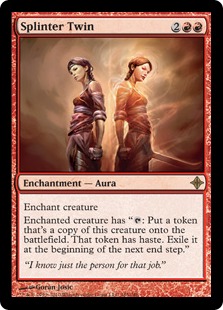 By a similar token, Wizards' decisions can sometimes feel at odds with the few mission clues that are out there. Many point to Splinter Twin's banning as a recent example of this. Or Birthing Pod's ban before that. Or Deathrite Shaman's demise. Taken individually, all those cases, except maybe Twin, saw Wizards righteously target a format-warping deck with a surgical (or nuking) ban. Taken collectively, however, those bans feel contrary to Stoddard's promise that Modern provides a "stable metagame" and lets us "tweak the same deck week after week." A more inclusive definition would anticipate that discontent and maybe even mitigate it in the future. Unfortunately, as with the Bloom case, there is no such mission if we want arbitration for these enduring Modern debates.
By a similar token, Wizards' decisions can sometimes feel at odds with the few mission clues that are out there. Many point to Splinter Twin's banning as a recent example of this. Or Birthing Pod's ban before that. Or Deathrite Shaman's demise. Taken individually, all those cases, except maybe Twin, saw Wizards righteously target a format-warping deck with a surgical (or nuking) ban. Taken collectively, however, those bans feel contrary to Stoddard's promise that Modern provides a "stable metagame" and lets us "tweak the same deck week after week." A more inclusive definition would anticipate that discontent and maybe even mitigate it in the future. Unfortunately, as with the Bloom case, there is no such mission if we want arbitration for these enduring Modern debates.
The Twin and Bloom scenarios are two recent examples of where the lack of clear Modern purpose gets us into trouble. We could also easily have pointed to Modern prices (defining "accessibility"), the Pro Tour (connecting Pro Tour "shakeup bans" to subsequent format instability), unbannings (determining appropriate Modern power level), and many other recurring issues. These debates, and their underlying problems, exist in no small part because of the uncertainty surrounding Modern's objectives. This makes defining that mission Priority #1 before we or Wizards can embark on any other "Fixing Modern" operations.
Three Steps to a New Modern Mission
Having investigated the existing, inadequate definitions of Modern, and having seen why those inadequacies are problematic for long-term format health, we can finally get to some solutions. I'm tempted to go all academic here and reveal there actually is no solution! We've explained the problem and now, esteemed colleagues, we turn to our noble peer researchers to devise the solution! Just kidding. You're either done with higher education and academic double-speak, or you're happy it isn't upon you yet. Either way, here are two steps Wizards and the content providers can take to resolve these issues:
- Wizards: Decide on a Modern mission and publish on the "Formats" page
Neither new players, format veterans, nor the Nexus Editor in Chief should have to search Google using "site:magic.wizards.com" queries to find the definition of a flagship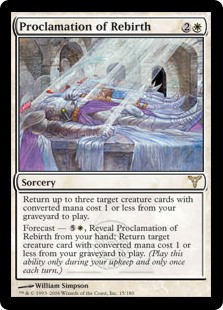 format. This information must be readily accessible, and the "Formats" page is the best home for it. If Wizards already has a working, internal definition the public isn't currently privy to, publish it. If Wizards has a definition they don't want to share with the public, rethink that definition and ask why it's so secretive. My suspicion is conversations would lead to revisions. If Wizards does not have a definition, internally decide on one and then post it. They have plenty of starting points cited in this article alone. Wizards should NOT crowd-source this process, or we'll be stuck at the "Asking the players" section and bogged down in surveys for a year. They should simply make their executive decision, which I would bet has already been made and is ready for public consumption, and then simply announce it. Using Stoddard's quote as a baseline, here's a Modern Nexus suggestion:
format. This information must be readily accessible, and the "Formats" page is the best home for it. If Wizards already has a working, internal definition the public isn't currently privy to, publish it. If Wizards has a definition they don't want to share with the public, rethink that definition and ask why it's so secretive. My suspicion is conversations would lead to revisions. If Wizards does not have a definition, internally decide on one and then post it. They have plenty of starting points cited in this article alone. Wizards should NOT crowd-source this process, or we'll be stuck at the "Asking the players" section and bogged down in surveys for a year. They should simply make their executive decision, which I would bet has already been made and is ready for public consumption, and then simply announce it. Using Stoddard's quote as a baseline, here's a Modern Nexus suggestion:
Modern is a non-rotating format that is more accessible and affordable than Legacy or Vintage. It features a stable metagame and a card pool that is more powerful than Standard's but less powerful than Legacy's and Vintage's. It allows players to play and tweak the same deck from year to year, and play a diverse range of strategies and archetypes.
- Pros/Authors/Coverage: Promote the newly minted, official definition
First, Wizards decides and distributes the mission. Next, the authors, commentators, professional players, and other Modern personalities need to adopt it. This means resisting the urge to make sweeping, populist generalizations about the format, and instead pointing to that definition as a banner behind which the community can rally. Does it need to get cited word-for-word in every single sentence about Modern? I certainly hope not. Should its spirit get conveyed in the content? Hopefully. By pulling back from the rhetoric-heavy, substance-light definitions as seen in the Pro Tour Previews, all content providers can help advance Modern towards a more unified understanding of the format.
Taken as a whole, this process would propel us from our current state of perpetual Modern uncertainty to firmer ground. Of course, players would also have to get on board too, and a third step could easily be "Players: Resist misleading/inaccurate definitions." I'm hesitant to put too much burden on players, who have been uncommonly patient with some of Wizards' mismanagement in this realm, and I'm confident they would readily rally behind Wizards if they undertook these two steps.
I'm optimistic about this process, but I can think of a few objections both readers and Wizards would have. Here are two of the most salient and my responses, both dealing with the element of expectation management:
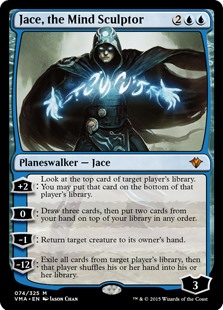 What if a public mission doesn't match player expectations and they leave in droves?
What if a public mission doesn't match player expectations and they leave in droves?
This is a big danger in formalizing a Modern mission. Right now, Modern can be all things to all players. Without an actual definition to cite, these players can all share equal levels of dissatisfaction with how Modern isn't addressing their personal needs. Once Wizards finalizes a purpose-statement, however, that uncertainty vanishes and some players might realize Modern actually is or isn't the format where they can one day play Jace, the Mind Sculptor. That should be a totally acceptable loss to both Wizards and the Modern playerbase. The benefits of increased format clarity far outweigh the short-term losses of those who are unhappy with Modern's newly defined goals, especially if that statement was an entry point (as I believe it is) to addressing all the other issues.
- Could a public mission create unfulfillable, long-term expectations?
A second danger surrounds impossible promises. Taking my sample purpose statement above as an example, if card prices ever approached Legacy levels, players might be even angrier than they would be otherwise because the mission promises otherwise. Does this risk, whether in prices, diversity, stability, or other qualities, mean we should not have a mission at all? Absolutely not! For one, Wizards could carefully select promises that were fulfillable: I believe, as do many others I know, that "availability" is deliberately used because you can guarantee it easier through reprints. "Affordability" is much trickier. Wordsmithing like this could help mitigate this risk. Second, I argue it's actually good for Wizards to have some lofty expectations to hold itself to. When your format is just a "nonrotating format from 8th Edition through present," the bar isn't very high. This would increase their public accountability while not creating a new Reserve List problem where Wizards is bound to an old promise.
Crafting statements like these is often difficult and contentious, but as we've seen throughout this article, the benefits far exceed the risks. I'll also add, it's a very rare thing to have an institution as widespread as Modern not benefit from a succinct mission, unless you really believe Magic needs to be a closed enterprise run by a corporate cabal. I don't think anyone here truly wants that, even if they might allege it, and a mission would help move away from that image.
Fixing Modern Together
On the topic of pressing and reasonable objections, here's another one I've both heard before and can read already in the comments: Modern is fine, event attendance is fine, the banlist is fine, stop complaining! Looking beyond the Eldrazi disaster, those defenses certainly have a kernel of truth to them. Grand Prix Philadelphia may not have had Grand Prix Richmond attendance figures, but the format does appear to be growing and expanding from year to year. Those who aren't interested in "Fixing Modern" will note this continued growth, and Wizards' continued support, as a sign that nothing needs to be changed.
I disagree. To begin, there's such a large subset of Modern players, whether in forums, writing articles, or at game stores, who loudly vocalize Modern problems at every turn. It's  naive to think the quieter Modern masses, who may well be a majority, aren't consuming that vitriol and getting dismayed. In my circle of about 20 Magic friends, I know of five who have either departed Modern due to the threat of bannings, or haven't made the Modern jump due to overall format uncertainty. If these discontented murmurs are affecting 25% of the Modern population, that's worrisome. Second, even if my 25% is not representative of all groups, I still believe there is a large, untapped body of Magic players who could be enjoying Modern but are not. This includes younger players and women, two major target demographics for Wizards. It includes Standard expatriates and Limited buffs. It includes kitchen table champions and Commander fans. Modern should not be all things to all people, but I believe there are enough of those Modernless Magicians out there that our format would only benefit by adding them. A mission starts that expansion.
naive to think the quieter Modern masses, who may well be a majority, aren't consuming that vitriol and getting dismayed. In my circle of about 20 Magic friends, I know of five who have either departed Modern due to the threat of bannings, or haven't made the Modern jump due to overall format uncertainty. If these discontented murmurs are affecting 25% of the Modern population, that's worrisome. Second, even if my 25% is not representative of all groups, I still believe there is a large, untapped body of Magic players who could be enjoying Modern but are not. This includes younger players and women, two major target demographics for Wizards. It includes Standard expatriates and Limited buffs. It includes kitchen table champions and Commander fans. Modern should not be all things to all people, but I believe there are enough of those Modernless Magicians out there that our format would only benefit by adding them. A mission starts that expansion.
Between those reasons and all those stated in today's article, I maintain "Fixing Modern" is an important and timely topic which we can approach in a constructive, informed, and conciliatory manner. I'm excited to hear what all of you think of today's article and the promise of more to come. Send me a message in the comments and I'll talk with all of you soon! Now, to convince that 7th grader to read this 4,300 word answer to his question...


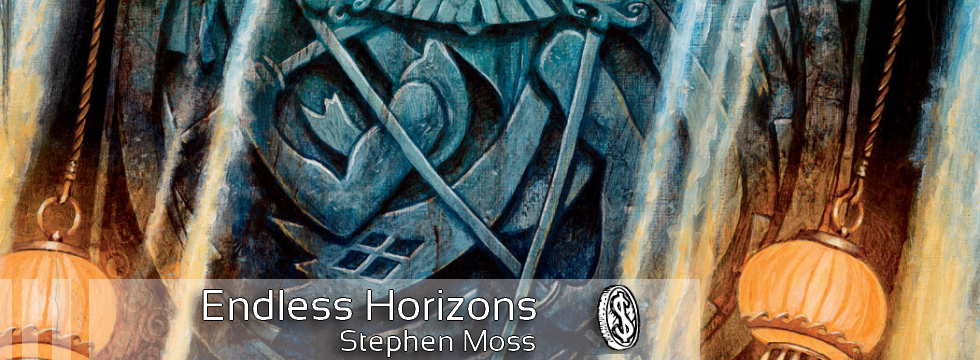


Huh.
When I got into Magic, I saw two things: the “old Magic” where things were designed with some very faulty assumptions and so stuff was totally broken, and “new Magic” where there was some real thought going into the bigger picture for how to design new cards. It was basically two different games, except if you were playing New somebody could bring in their Old cards and wreck you.
When I eventually started playing in local events, I was pleased to discover that there was a format (Standard) where Old wasn’t allowed, so I could play “real” (New) Magic. But then stuff kept rotating and it got expensive to keep up. But if I wanted to play “casually” (basically, “no format”) then I had to accept people’s use of Old stuff.
“Playing Magic” always carried a sort of assumption of getting to use any of your cards, but then dodging the Old stuff that really didn’t belong in Magic at all required this little spin-off variant called Standard that came at the price of having to keep rotating.
Thus, when I was introduced to Modern, I took it to mean “Let’s just play Magic, and all that Old crap is banned”.
I have since learned to appreciate the value of Legacy as its own perfectly legitimate way to play, but I still assert that there are basically two games: the original, and the new. Thus, to me, our format is named what it is because it just means “We’re playing the modern version of Magic.”
What is Legacy? It’s old Magic.
What is Standard? It’s the latest Magic.
What is Modern? It’s modern Magic.
When I came back to Magic: the Gathering in 2013, I had a similar response to the Modern format. It looked like an easy way to unify a group of players with disparate collections and varying levels of competitive interest. Modern seemed to be the best of both worlds as far as card availability and depth of card pool were concerned.
Does anyone else remember one of Modern’s early talking points being that the format benefited from a decade of design and development experience? In other words, it was a showcase for how Magic cards were designed in the modern day, and the overpoweredness of years past would not define or upset the new format? Perhaps I imagined this, as the sentiment isn’t present in anything cited above, but even as someone with fond memories of those older cards (I started playing in 1994), this idea was very appealing to me in regards to a non-rotating format. Given how Modern has been managed over the last few years, however, I’m not sure that was a reasonable expectation.
This article raised an important question, and was a great read. I’m looking forward to the rest of the entries in this series.
As an aside, after rereading Tom LaPille’s article, I question why the arbitrary starting point for Modern wasn’t Mercadian Masques. That was the first set free of the Reserve List, and he used the accessibility of Legacy staples on that list as a a major consideration in the format proposition. I’m still hopeful that we’ll get to play with some of those pre-Mirrodin sets in Modern one day.
I like this concept of old vs. new Magic for players who already have some intuitive grasp on what that means. But for many new players, and for even old ones with different experiences, this can still mean different things. It also doesn’t help us get out of some of Modern’s most challenging questions, especially if Modern Magic is just “modern Magic,” adding another relatively subjective definition to the already subjective duo of old vs. new. For instance, those three terms don’t really tell us if JTMS is appropriate for Modern or not. That makes them good at maybe referencing a format, but not great at describing what it should be and what purpose it should have.
Modern is a Non-Rotating format. There is your definition. The question would be how would you characterize the environment of modern. And at current I would say that Modern is an environment ill-equipped to regulate itself against the politics of wizards of the coast. The reluctance to make answers that compare to the quality of the interaction they produce is poor… for wanting an interactive format.
Although I’m definitely a fan of calling something a nonrotating format as a way to start off the conversation, I think a proper Modern definition needs much more than that. I also believe there is an unmoving definition of Modern that is independent of the specific environment Wizards or players wants to create. Or, if you are referring to the unchanging environment of Modern (kind of like how Legacy has a certain kind of unchanging environment), I would just say the concept of a “definition,” as I use it, and an “environment,” as you do, are actually the same thing. Once that gets better defined, we can start answering questions about politics, interaction, power level, etc.
Great article Sheridan. I agree that this question and its non-answer from Wizards is central to Modern’s issues, at least for me. I had the incorrect assumption of Modern for a long time which was blasted to bits with Twin’s banning.
I’ve been playing Magic for 20+ years and always believed wizards only bans when something is BROKEN. DRS seemed broken. Pod not so much, though I was willing to look past this decision since so many others thought it was. There was absolutely nothing broken about Twin. If it had a slightly higher power level then the rest of the format, then raise the rest of the format to match, don’t cut it down. I say this as an affinity player.
I digress into banlist talk because it perfectly illustrates how I misunderstood Wizard’s format intentions. I thought they wanted Modern to be a place where inherently powerful (albeit not broken) strategies could exist and that those strategies would continue to exist as long they did not break the format.
Wizard’s vision for the format can be pieced together even if they won’t state it. Sadly, it doesn’t match what I want from a non-rotating format.
Amen! I do think banlist issues are huge in this “Fixing Modern” question, and your example of banning broken cards is a good one. Wizards has taken a very surgical, at best, and hamfisted, at worst, approach to bans in Modern. I know many players don’t like it, as it seems like (as I’ve argued before) an artificially induced metagame rotation when there is a deck that is only slightly better than all the rest. For me, that’s totally fine in a nonrotating format. For Wizards, they apparently want something different. Better definitions would help us figure out what to expect from Wizards so we aren’t blindsided by these changes in the future.
This was a really great article! Great read. I love the questions you are raising and I agree with you in pointing put Sam Stoddard’s ‘definition’ as a good place to start to define modern.
Personally, even though I’ve never played legacy, when I look at legacy decks vs modern decks I always feel modern is a very creature-centric format vs legacy being much more spell heavy.
This might be quite the oversimplification and not that important to many players but to me the importance of creatures in most modern decks is what appeals to me. And one day I know my beloved Goblins will become viable!!
P.s. love the site. Love the articles. I’d love more videos like Trevor was doing for awhile I learned a lot from them.
Glad you enjoyed it! I too was really happy with Stoddard’s “definition” and wish Wizards would use it (or one like it) more. I do think creatures are an interesting element of the question, and one that isn’t covered by Stoddard’s definition or my edited one. Not sure if that’s just a means to achieving an end or actually part of the definition itself. Hopefully Wizards can just go out there and define the format in clearer terms one day. Thanks for reading and hopefully we’ll get some more video content up soon.
Really looking forward to this column!
There is a huge gap between standard on the one hand and legacy on the other.
Standard is super narrow because of rotation and few cards being legal.
Legacy is inaccessible due to the reserved list. Also, legacy is very restrictive on mana cost: The existence of Wasteland/Stifle/daze/Fow makes cards with cc4 or higher unplayable for the most part. This reduces the diversity of viable strategies, makes transition from standard difficult and reduces the impact of new sets coming out.
Because of this, there is high demand for a format to bridge the gap between legacy and standard. A format for all the sweet strategies that are not good enough for legacy but not legal in standard.
Most of moderns popularity comes from this demand.
But this is due to lack of alternative and not due to how good a job modern does at satisfying this demand.
Modern is not all we want from it, but it is the best we got.
I am interested to read your views on how to fix modern so that it better fits the demand!
Personally, I would love wizards to change modern to overextended (add odyssey, invasion, onslaught blocks and 7th edition) and adjust the banned list accordingly.
This would be a rather broad change and I don’t really see them doing it. But a man can dream…
Excited to do more of these columns! I think you’re right to point to the Standard and Legacy power-gap as an importance space for Modern to fill. Unfortunately, because that divide is HUGE and because Modern is ill-defined, it’s hard to know where Modern sits between the two formats. It’s clearly in the middle, but we don’t know exactly where. Like you, I feel we are stuck with Modern as this middle format, but also feel it isn’t meeting the demand of players like us. Overextended would have been absolutely awesome, or even “Eternal”/”Unreserved” with no RL cards and a Legacy cutoff. But if Wizards really is sticking with Modern, an assumption I’m working with, there are things they can do to make it better. I’ll touch on more of those fixes in future columns!
The difference between Modern and Legacy really comes down to the counter magic and Wasteland. Without those, Modern became a linear and proactive format where people are jamming everything they can at you. I really dont think it became the format that everyone wanted, unfortunately.
I know Modern is supposed to be a turn 4 format, but damned if those matches arent faster than a typical Legacy match. I feel like every Modern match is very lopsided and decided by turn 3 or 4, because even if you arent technically dead on turn 3, you could have no hope of beating what your opponent is doing. Conversely, any good Legacy storm players knows they cant just jam their combo on turn 2 in that format. Most of the game you are jockeying for position since ‘free’ counter spells can falter every deck.
Modern is, here is my game plan, try and stop me. Which, given the card pool, probably cant be stopped very easily. So, your opponent is simply ignoring your game plan and trying to fire off their own, faster. Love it or hate it, there is a reason why blue is one of the main 5 colors, and you need it to be present in all its flavor for balance as a whole.
TLDR: Modern counter magic sucks donkey balls and, whether you like it or not, the format is shit due to that.
Totally agree that the lack of countermagic (and, more broadly, generic answers) is a serious problem in Modern. This is the foundation behind the timeless Modern complaint about high variance games, the matchup lottery, the importance of sideboarding, etc. If we had more Modern-appropriate Bolt, Decay, Path, Thoughtseize/IoK, and other policing effects, the format would be much tamer, much more interactive, and much less ban obsessed. This will definitely be something I talk about in a later column entry.
Thank you for writing this article. It made me feel like I was reading an academic paper.
Thank you for putting in paper what fair share of players are feeling in such a meticulous way.
Happy to hear you enjoyed it! It was fun to write and I hope the other articles also put into writing what many Modern players feel every day.
the format is really going to suffer until Wizards diverts some resources to it and that’s only going to happen when they realize how much value it adds to their brand….
having magic just be about standard is not what has brought the game to where it is today… and modern/extended hasn’t done it alone either… it’s all part of the big pie…
sadly they are watching the bottom dollar figures… and modern doesn’t impact it a ton directly… i would argue that it has pushed the brand further and the value is very much intangible… but as a player you can very much feel it… continually playing standard is just not appealing to a large swath of the playerbase…
once they realize how valuable the format is in that regard.. the format will get better… i just hope that they will eventually…
For me the existence of modern has a negative impact on how many booster boxes I buy.
The reason is that I cant help but feel a little disappointed about a new set when there is no reprint that adds something to modern (like counterspell or Goblin Ringleader).
I do know that those cards just don’t belong in standard. But still…
Like with SoI: I know they wont reprint Wild Mongrel or Basking Rootwalla.
But I would like to have those in modern, so I get upset.
I think if those cards already were in modern I would be able to appreciate SoI much more for what it is. (and as a consequence buy more of it)
I think this is mostly a function of bad marketing decisions by Wizards. Why not just reprint a few good Modern cards every set? Or print new ones? As in, every time a set comes out, have a few members of R&D commit themselves to getting 2-3 cards into that set that are specifically designed and tested for Modern. The resource investment wouldn’t be that huge, and there are plenty of ways they could do this efficiently. Or even just reprinting existing Modern staples to drive sales, putting them randomly into packs to increase demand. All of these ideas are on the table in future “Fixing Modern” columns and I’m excited to see where Modern heads this year.
Strongly agree with this. Without realizing the value of Modern, and without devoting the commensurate resources, Wizards is losing a lot of potential from this awesome format. There are a lot of branding decisions they could make with Modern to both justify that resource investment and get more value from it, and until Wizards starts treating it more seriously, I fear the format is still going to get treated with much less dedication than Standard or Limited.
This was well thought-out, well argued, and well presented. I fuck with it.